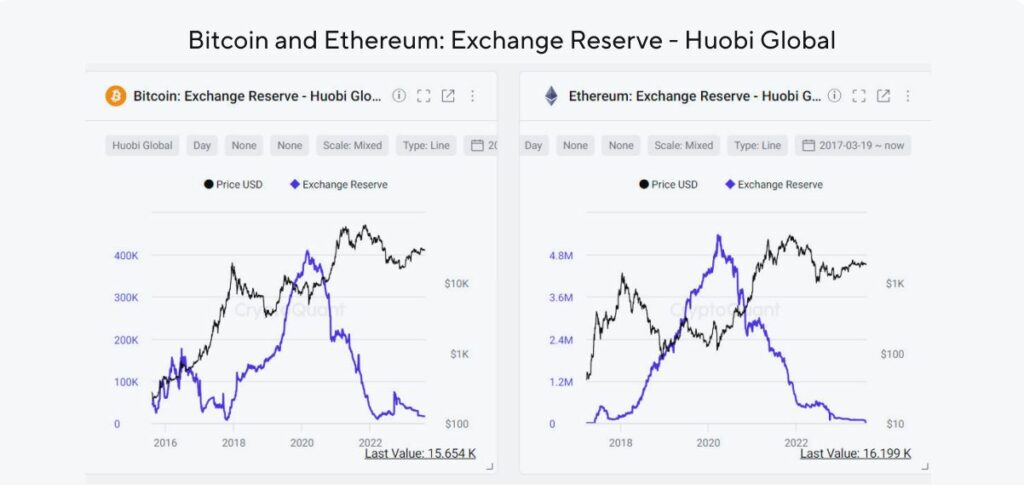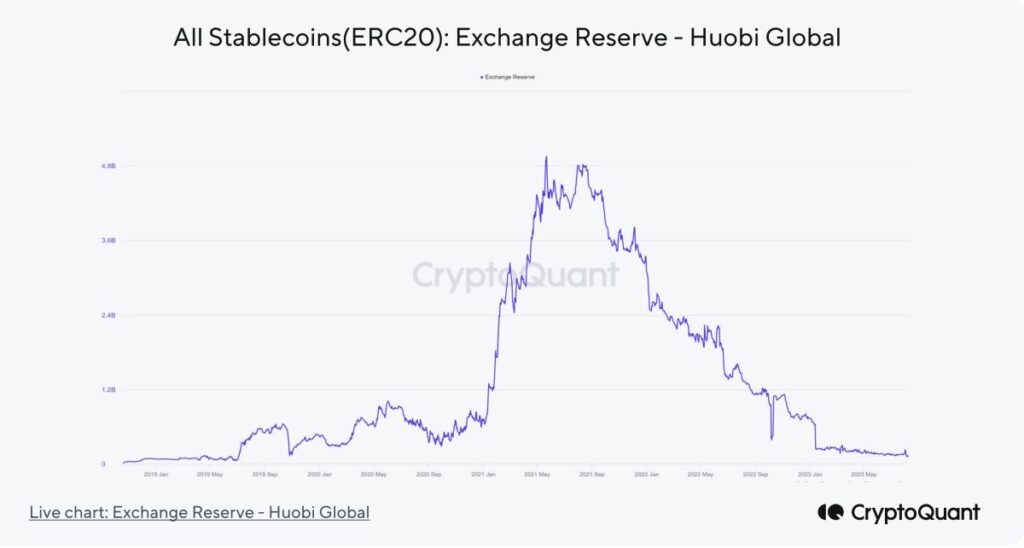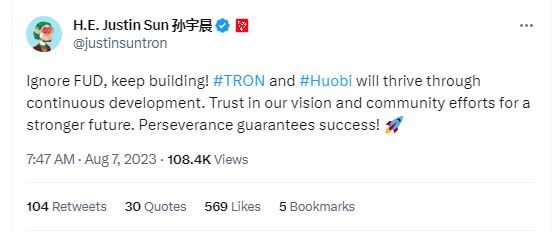Key Takeaways:
- Huobi outflows are not new. Stablecoins, BTC, and ETH have left the exchange consistently since 2020.
- The outflow from exchanges is ubiquitous, not endemic to Huobi.
- Meanwhile, the platform DOES face issues, and Justin Sun is one of them.

YEREVAN (CoinChapter.com) — Huobi exchange has been the center of much controversy lately. The outflows of Bitcoin and Ethereum from the platform sparked rumors of its looming insolvency. Or was it the other way around? Let’s see.
Huobi outflow has been consistent since 2020
According to an Aug 9 report from on-chain tracker CryptoQuant, Bitcoin, Ethereum, and stablecoin outflows from Huobi have been consistent since 2020 and have been at near-record-low levels
since early 2023.

Erik Anderson, Senior Research Analyst, Global X, agreed. He told CoinChapter that by itself, the flow of bitcoin to and from exchanges is not a strong indicator of price momentum, as “this trend has persisted through the bull market of 2020-2021 and the bear market of 2022.”
Stablecoin reserves also took a hit, flatlining near all-time lows.

Moreover, 2020 marked a downtrend in Bitcoin reserves across all the exchanges, not Huobi exclusively. The demand for self-custodial solutions was further triggered by Terra and FTX collapse and intensified by heightened scrutiny from the regulators.

Despite the above factors, do NOT downsize Huobi’s internal issues. For example, the exchange relies heavily on its in-house HOT token, which makes up 30% of its reserves – an alarming amount for a high-tier exchange with a daily trading volume north of $1 billion.
Huobi has the smallest percentage of clean reserves compared to other major crypto exchanges.
Clean reserves refer to reserves that do not include self-issued tokens. According to the CryptoQuant report, Bitfinex and Binance take second and third rank with under-25% and under-10% of in-house tokens, respectively.
Outflows spiked after the Huobi insolvency rumor
However, outflows on Huobi did spike in early August, spurred by the insolvency rumors, as seen in the chart below.

In detail, the success or failure of Centralized Exchanges (CEX) is largely based on trust. Clients entrust their funds to the platform. The platform, in turn, makes trading more straightforward. However, once the trust is compromised for any reason, real or imaginary, clients might flee in bulk, akin to a real-life bank run.
Huobi has liquidity issues and has faced large outflows since 2020.
Additionally, the association with Justin Sun, a controversial figure in the crypto sector, does not do Huobi any favors. However, one spark from a customer, a competitor, or a former employee could be enough to start a wildfire.
Sun responded to Huobi exchange’s insolvency rumors, urging his audience to “ignore the FUD and keep building.”

However, his calls for trusting the vision ring hollow as accusations of personal involvement in the USDT outflow build, compromising client trust in Huobi.
How did the Huobi Insolvency rumor start?
Adam Cochran, a fintech executive and an angel investor, tweeted about the abnormal Tether (USDT) outflows from the Huobi exchange on Aug 6, after Huobi launched its Staked USDT (stUSDT) product. He reported that Binance had commenced the bulk sale of USDT on top of the “weird balance shifts at Huobi in the last month.”
Just like with FTT, Binance is often the first to know about risky assets or issues within the industry due to its scales and connections. And if we look at the time stamps of Friday’s rapid sell off of USDT, it’s after the time Huobi employees would have been questioned.
asserted the expert in a lengthy thread.
Moreover, Cochran asserted that the police are questioning Tron and Huobi employees. However, the Community Manager at the exchange denied the questioning, calling claims of Huobi exchange insolvency pure rumors.
Is Huobi Justin Sun’s personal purse?
Meanwhile, the numbers at Huobi don’t add up. Tron’s website shows over 350,000 stakers of USDT (stUSDT holders) on the chain. However, Cochran claims that 98% of the token supply is held by “Sun or Huobi directly.
“When you “stake” USDT into stUSDT, it gets swept into a Huobi deposit address,” asserted the executive.

Moreover, Tron does not hold enough USDT to back the stakers. According to Cochran, the exchange holds only $90 million in USDT and USDC combined.
Huobi’s own ‘Merkle Tree Audit’ still lists that Huobi users have $630M of USDT held and a wallet balance of $631M USDT—users think they have balances of $631M in Huobi, but there is only $90M there.
he said.
The missing funds, Cochrane alleged, are being used to prop up the yields of Tron, Poloniex, and other DeFi apps operated by Sun.


